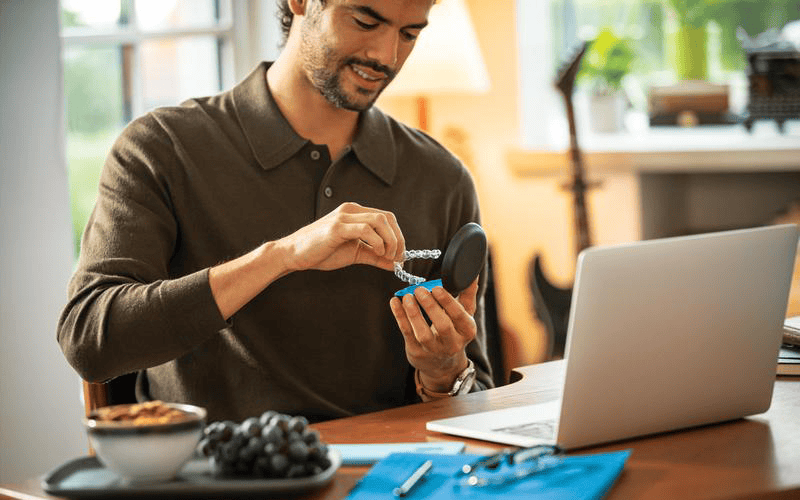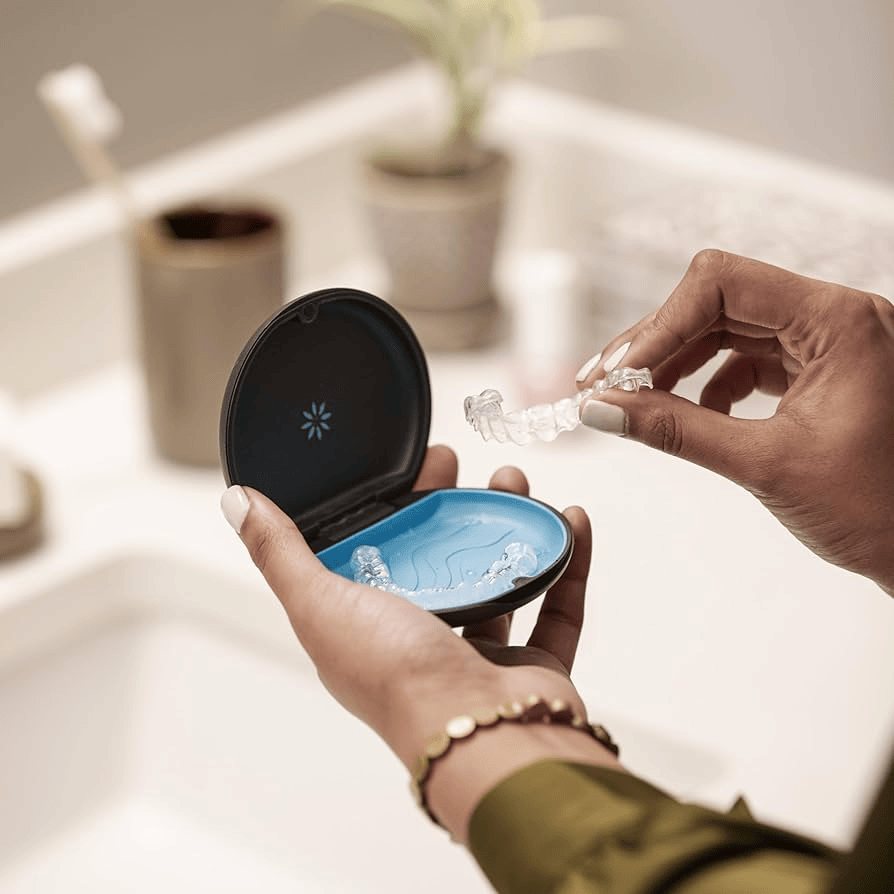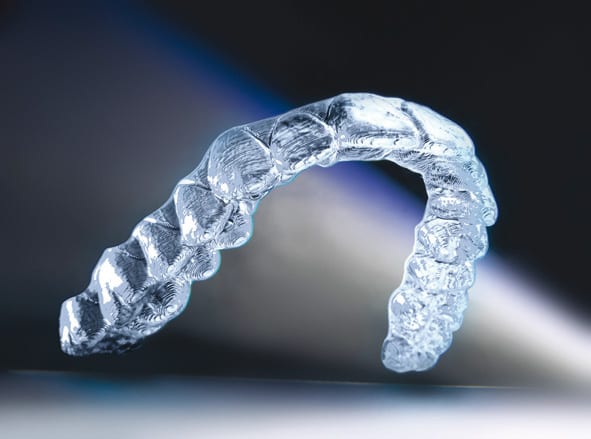Invisalign clear aligners transformed orthodontics more than 20 years ago, pioneering a nearly invisible way to straighten teeth under the supervision of licensed orthodontists. Today, mail-order teeth aligners and teeth straightening kits offer a direct-to-consumer approach, letting patients straighten teeth at home—without in-office visits or professional monitoring.
While both options involve using clear braces to move teeth, the level of clinical oversight, material quality, safety, and long-term treatment outcomes vary significantly. If you're considering Invisalign vs. mail-order aligners, this guide explains the key differences to help you make an informed choice—and get the best results for your smile.
Table of contents
Are Mail-Order Aligners Cheaper than Invisalign?
How do treatment costs compare?
Mail-order clear aligners often advertise lower base prices—typically around $2,000 for a six-month treatment. However, this headline Invisalign alternative price rarely includes critical items like x-rays, diagnostic records, Invisalign attachments, refinements, or post-treatment Invisalign retainers. Many patients ultimately pay more out of pocket when they add these services separately.
By comparison, Invisalign near me providers usually offer all-inclusive pricing—starting around $2,400 for mild-to-moderate cases—which covers full diagnostics, aligner trays, attachments, refinements, and final retainers. Invisalign also uses patented SmartTrack™ material designed specifically for precision tooth movement, while most mail-order brands rely on generic plastic.
If you’re wondering how much is Invisalign with insurance? Many Invisalign providers also offer flexible payment plans and will coordinate with insurance directly—unlike mail-order brands.
Key Invisalign vs. mail-order cost considerations:
Mail-order aligners often exclude x-rays, attachments, or refinements
Invisalign fees typically include diagnostics and retainers
Invisalign uses advanced SmartTrack™ material for superior movement
Professional supervision can help reduce long-term retreatment costs
Do Mail-Order Aligner Brands Use Invisalign Aligners?
Invisalign aligners are in a completely different category from mail-order teeth aligners and teeth straightening kits. Invisalign aligners are made with SmartTrack™ material that is specifically engineered by Align Technology to provide controlled, gradual, and predictable tooth movement. They are only available through certified Invisalign provider orthodontists or dentists.
In contrast, mail-order aligners use off-the-shelf plastic that lacks the elasticity and precision of Invisalign aligners. These clear aligners are manufactured based on self-taken impressions or in-store scans without the critical involvement of an orthodontist. This is a key reason why Invisalign reviews consistently report higher satisfaction, better outcomes, and fewer complications than mail-order alternatives. Patients should understand that no mail-order aligner is equivalent to Invisalign clear braces in terms of technology, fit, or treatment capabilities.
Is Smile Direct Club aligners made by Invisalign?
No—Invisalign aligners are only available through licensed orthodontists and dentists and use proprietary SmartTrack™ and SmartForce™ technologies that are not available with mail-order aligners. Invisalign aligners are fabricated using precise iTero® digital scans and crafted to address both cosmetic and complex tooth alignment needs.
Mail-order aligner companies instead rely on generic BPA-free plastic and DIY impressions. They lack the ability to use advanced Invisalign attachments, elastics, or iTero 3D modeling.

Difference in Technology
Invisalign clear aligners offer superior control, comfort, and precision because they are backed by over 20 years of Align Technology research. Invisalign’s proprietary materials and orthodontist-driven treatment planning deliver more predictable tooth movements compared to off-the-shelf plastic used in most mail-order brands.

Do Mail-Order Aligner Brands Take X-Rays?
Mail-order aligner brands do not include dental x-rays or professional diagnostic imaging—leaving a major gap in the treatment process. Without x-rays, critical issues like root positioning, jawbone density, impacted teeth, or gum disease can go undetected, increasing the risk of tooth mobility, gum recession, or bite instability during treatment. In contrast, Invisalign treatment through an Invisalign provider includes a full diagnostic workup, starting with dental x-rays and iTero® 3D scans. This ensures a complete view of oral health before any teeth straightening begins. When patients search for Invisalign near me or wonder how does Invisalign work, part of the answer lies in this upfront, thorough diagnostic process—one that DIY teeth aligners simply cannot match.
Why are x-rays important for aligner treatment?
Mail-order brands do not include dental x-rays in their packages—a key diagnostic gap. In contrast, Invisalign treatment includes comprehensive diagnostics, including x-rays and iTero scans, as part of the initial Invisalign consultation. This helps orthodontists assess root health, bone structure, and any underlying conditions that might affect treatment success.
Without x-rays, mail-order aligner companies may miss critical dental issues that could lead to tooth mobility, gum recession, or bite instability.
What additional benefits do in-office consultations provide?
Licensed Invisalign providers offer a comprehensive oral health assessment—including screening for gum disease, cavities, and bite issues—before starting treatment. The process also includes digital scans to ensure a perfect fit for your Invisalign aligners. By contrast, mail-order kits rely on self-taken impressions and photos—an inferior approach that can compromise treatment success.

Does Insurance Cover Mail-Order or Invisalign Clear Aligners?
How does insurance coverage compare?
Wondering does insurance cover Invisalign? If you have dental insurance with orthodontic benefits, your policy is much more likely to cover Invisalign treatment because it is supervised by licensed professionals. Many Invisalign orthodontist offices also handle insurance claims on your behalf.
DIY aligners from mail-order brands typically lack professional oversight and therefore often do not qualify for insurance reimbursement. If coverage exists at all, patients must request reimbursement themselves, and it may be partial.
What other financial factors should be considered?
In addition to stronger insurance support, Invisalign providers offer flexible payment plans and 0% financing. Mail-order aligners typically require upfront payment or financing through third-party lenders.
When considering Invisalign cost vs. mail-order aligners, remember to factor in clinical quality, supervision, and potential long-term savings by avoiding retreatment.
What Is the Difference Between Mail-Order and Invisalign Clear Aligners?
How do materials and fit compare?
Invisalign clear aligners use proprietary SmartTrack™ material that offers superior comfort, flexibility, and precision tooth movement. Most mail-order aligners rely on generic clear plastic, resulting in a looser fit and less predictable results.
What are the clinical advantages of Invisalign?
Choosing Invisalign treatment over mail-order teeth aligners means gaining access to the full scope of Align Technology innovations. Invisalign clear aligners use SmartForce™ attachments that enable orthodontists to achieve complex tooth movements—such as rotations, root torque, and vertical control—that are impossible with basic mail-order clear aligners.
Invisalign’s proprietary iTero® scanner technology ensures a highly accurate digital 3D model of your teeth, enabling a custom treatment plan with more predictable results. In addition, Invisalign providers use ClinCheck software to plan and optimize every movement of each tooth throughout the treatment process. This advanced level of care cannot be replicated by DIY teeth straightening kits. Ultimately, Invisalign vs braces vs mail-order aligners is not an equal comparison—only Invisalign offers this level of clinical precision in a removable clear aligner system.
Can Mail-Order Aligners Treat the Same Conditions as Invisalign Treatment?
When it comes to treating a broad range of orthodontic conditions, mail-order aligners fall short. While they may help with minor aesthetic issues like mild crowding or spacing, they are not designed to address complex orthodontic problems.
Invisalign aligners, guided by a licensed Invisalign orthodontist, can treat a much wider range of dental conditions—including overbite, underbite, crossbite, and more severe misalignments. Invisalign can also integrate the use of Invisalign elastics and attachments to improve treatment outcomes, something mail-order options simply can’t provide. For patients who want true teeth straightening—not just slight cosmetic changes—Invisalign remains the superior choice.
Limitations on Mail Order Aligners
Mail-order aligners are designed for teeth straightening at home, but they can only address mild cosmetic issues. Without in-person monitoring, they cannot safely handle:
- Severe crowding or spacing
- Bite correction (overbite, underbite, crossbite)
- Tooth rotations
- Complex tooth alignment or jaw issues
- Monitoring root movement and bone health
- Choosing the Right Aligner Treatment for You
If you’re wondering is Invisalign worth it? —the answer lies in the level of care you want. Invisalign offers a professional, proven path to a healthier, straighter smile under the supervision of an orthodontist. While teeth aligners at home may seem convenient, the risks and limitations can outweigh the short-term savings.
Benefits of Choosing Invisalign Over At-Home Aligners
There are clear and measurable advantages when choosing Invisalign over mail-order aligners for teeth straightening. Invisalign aligners offer unmatched clinical capabilities—whether you’re looking for Invisalign for adults, Invisalign for teens, or even Invisalign Express for quicker cosmetic fixes.
Treatment is guided by an Invisalign provider who can customize your plan, monitor progress, and make adjustments in real time. The use of SmartTrack™ material and SmartForce™ attachments gives Invisalign a proven edge over generic teeth aligners at home. Plus, Invisalign includes comprehensive x-rays and 3D scans to ensure treatment is safe and effective. For patients who want predictable results and long-term smile stability, Invisalign is the clear leader.
Top reasons to choose Invisalign:
- Treatment guided and monitored by a licensed orthodontist
- SmartTrack™ material ensures superior comfort and tooth movement
- Ability to treat complex orthodontic cases with attachments and elastics
- Comprehensive diagnostics, including x-rays and 3D scans
- Stronger insurance coverage and financing options available
Can Mail-Order Aligners Replace In-Office Invisalign Treatment?
Risks associated with mail-order aligners
While mail-order aligners may initially seem like a convenient and low-cost Invisalign alternative, they do not offer the clinical safety or effectiveness of an Invisalign treatment plan. Without x-rays or professional supervision, patients are left to manage their treatment on their own—an approach that can result in tooth damage, bite problems, or worsening alignment.
Invisalign orthodontists provide expert care and can adapt treatment as needed to ensure optimal outcomes. Invisalign also addresses conditions that mail-order aligners cannot—such as cases requiring bite correction or root alignment. For any patient considering at-home teeth aligners, understanding these risks is crucial.
When might Invisalign be the safer choice?
Invisalign clear aligners are the safer choice in virtually all cases requiring comprehensive orthodontic correction. Complex bite issues—such as overbite, underbite, or crossbite—require precise, controlled tooth movement that only Invisalign, with orthodontist oversight and advanced SmartForce™ attachments, can provide. Severe spacing or crowding, rotated teeth, and cases needing root monitoring or gum support are also best treated with Invisalign, where an orthodontist can adjust the treatment plan as needed. Mail-order aligners simply lack the clinical tools, materials, and supervision required to manage these more advanced dental conditions. For patients comparing braces vs. Invisalign vs. mail-order aligners, Invisalign remains the clear winner for anyone seeking safe treatment, predictable outcomes, and long-lasting results.
Treatment Experience of Invisalign vs. Alternative Aligners
The Invisalign treatment experience is built around clinical excellence and patient support. From your first Invisalign smile test to your final Invisalign retainer, every step of the process is guided by a trained orthodontic professional.
By contrast, mail-order aligner brands rely heavily on self-reported progress through photos and lack meaningful orthodontic oversight. Invisalign patients benefit from in-person Invisalign near me appointments, regular progress checks, and expert adjustments—making the entire process more personalized and predictable. If you value a premium experience and the assurance of safe tooth movement, Invisalign delivers far greater value.
Key differences in experience:
- In-person Invisalign near me consultations and progress checks
- Orthodontist-monitored treatment plan adjustments
- Predictable results using proprietary Invisalign technologies
- DIY aligners rely on customer-reported photos and self-managed progress
What Are the Long-Term Outcomes of Invisalign vs. Mail-Order Aligners?
Long-term success with teeth straightening depends heavily on treatment quality and follow-up care. Invisalign’s system of controlled tooth movements, professional supervision, and customized post-treatment Invisalign retainers helps ensure that your results last.
In contrast, mail-order aligners lack the clinical safeguards necessary to produce stable outcomes. Many patients report needing additional retreatment after mail-order aligner use, which can ultimately result in higher costs and more frustration. For patients seeking a trusted way to straighten teeth with proven long-term stability, Invisalign is the better investment.
How do treatment results compare?
Invisalign aligners are guided by an Invisalign orthodontist and supported by advanced technologies like SmartTrack™ material and iTero® digital modeling, patients experience more precise, controlled tooth movement throughout the process. Invisalign can also provide safer, more predictable bite correction—something DIY teeth aligners at home cannot offer.
Invisalign provides superior long-term results thanks to:
Precise, controlled tooth movement
Safer bite correction
Professional follow-up and Invisalign retainers to maintain results
How does follow-up care compare?
Follow-up care is critical to maintaining your new smile. Mail-order teeth aligners typically offer little to no structured follow-up. Without ongoing orthodontic support, patients face a greater risk of relapse and bite issues. Invisalign patients benefit from having an ongoing relationship with their orthodontist, ensuring that their smile remains healthy and stable for years to come.
Follow-up care is another major differentiator:
Invisalign provides ongoing monitoring and customized retainers
Mail-order brands typically offer little or no post-treatment follow-up
Stable results and minimizes the risk of retreatment
Do mail order teeth aligners work?
Mail-order teeth aligners can sometimes straighten teeth for patients with very mild to moderate cosmetic alignment issues. However, their capabilities are limited. Without in-person orthodontic oversight, mail-order aligners cannot safely manage complex cases such as bite correction, rotated teeth, or severe crowding. Patients are expected to manage their treatment independently—taking their own impressions, tracking progress through photos, and navigating any issues without the support of a trained orthodontist. As a result, these at-home kits often deliver only basic cosmetic improvements, and the lack of professional monitoring increases the risk of incomplete or unstable results.
Is there a lawsuit against Smile Direct Club?
Yes. SmileDirectClub filed for bankruptcy in late September 2023 after accumulating nearly $900 million in debt. The company has also faced legal action for allegedly using non-disclosure agreements to restrict customer feedback and manipulate online reviews—preventing consumers from reporting negative experiences to regulatory authorities. These lawsuits highlight growing concerns about transparency and accountability within the mail-order aligner industry.
Why do dentists not recommend SmileDirectClub?
Many dentists and orthodontists strongly advise against using DIY dental aligners like SmileDirectClub. Consumer alerts have been issued nationwide, warning that unsupervised mail-order aligner treatment can result in serious, lasting damage to teeth, gums, and overall oral health. Without comprehensive diagnostics or in-person monitoring, these treatments can cause improper tooth movement, bite misalignment, gum recession, or bone loss. As orthodontic specialist Dr. Lee and many colleagues emphasize, aligning teeth without professional guidance is risky and should be avoided.
Does insurance cover Invisalign?
In most cases, yes—many dental insurance plans do cover Invisalign treatment, often in the same way they cover traditional braces. Depending on the plan, coverage may range from 25% to 80% of treatment costs, with some policies offering up to $3,000 in orthodontic benefits. However, coverage varies significantly between providers and policies, so patients should consult their insurance company or Invisalign provider to confirm specific benefits. One advantage of Invisalign treatment is that most orthodontic offices handle insurance billing directly—making it easier for patients to maximize coverage and minimize out-of-pocket costs.
Conclusion
When comparing Invisalign vs. mail-order aligners, the clinical differences are clear. Invisalign offers professional supervision, advanced materials, proven technologies, and the ability to treat a wider range of orthodontic issues safely.
While teeth straightening kits may seem appealing for convenience and price, they come with significant risks—especially for patients seeking long-term stability and a truly healthy smile.
For patients wondering how much does Invisalign cost or how long does Invisalign take?—consulting with a licensed Invisalign provider near you ensures that you receive expert guidance and treatment tailored to your needs.
From clear braces for adults to Invisalign for teens, Align Technology and trusted orthodontists continue to deliver transformative results that at-home kits simply can’t match.
Your smile is an investment—choose Invisalign for results you can trust.






